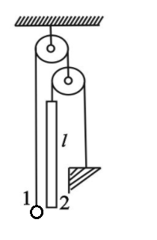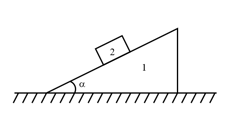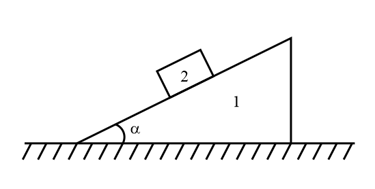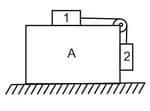In the arrangement shown in the figure, the mass of the rod exceeds the mass of the ball. The ball has an opening permitting it to slide along the thread with some friction. The mass of the pulley and the friction in its axle are negligible. At the initial moment the ball was located opposite the lower end of the rod. When set free, both bodies began moving with constant accelerations. Find the friction force between the ball and the thread, if seconds after the beginning of motion the ball got opposite the upper end of the rod. The rod length equals .



Important Questions on PHYSICAL FUNDAMENTALS OF MECHANICS
In the arrangement shown in figure, the mass of ball is times as great as that of rod . The length of the latter is . The masses of the pulleys and the threads, as well as the friction, are negligible. The ball is set on the same Ievel as the lower end of the rod and then released. How soon will the ball be opposite the upper end of the rod? (Take )

In the arrangement shown in the figure, the mass of body is times as great as that of body . The height . The masses of the pulleys and the threads, as well as the friction, are negligible. At a certain moment, body is released, and the arrangement is set in motion. What is the maximum height that body will go up to?
Find the accelerations of rod and wedge in the arrangement shown in figure, if the ratio of the mass of the wedge to that of the rod equals and the friction between all contact surfaces is negligible.
In the arrangement shown in the figure, the masses of the wedge and the body are known. The appreciable friction exists only between the wedge and the body , the friction coefficient being equal to . The masses of the pulley and the thread are negligible. Find the acceleration of the body relative to the horizontal surface on which the wedge slides.
What is the minimum acceleration with which bar should be shifted horizontally to keep bodies and stationary relative to the bar? The masses of the bodies are equal, and the coefficient of friction between the bar and the bodies is equal to . The masses of the pulley and the threads are negligible, the friction in the pulley is absent.
Prism with bar of mass placed on it gets a horizontal acceleration directed to the left. At what maximum value of this acceleration will the bar be still stationary relative to the prism, if the coefficient of friction between them ?

Prism of mass and with angle rests on a horizontal surface. Bar of mass is placed on the prism. Assuming the friction to be negligible, find the acceleration of the prism.

In the arrangement shown in figure the masses of the bar and of the wedge, as well as the wedge angle , are known. The masses of the pulley and the thread are negligible. The friction is absent. Find the acceleration of the wedge .





